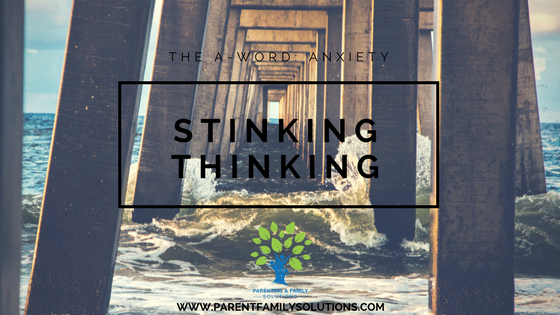
You’re awful!
You treat yourself like crap!
And it’s because of the way you think.
So many of us were taught how to take care of ourselves physically through diet and exercise, being active, living life to the fullest.

Few are taught how to have healthy thoughts
But not too many were taught how to think healthy thoughts.
In fact, some of us work so hard at caring for ourselves or being successful because of our “stinking thinking”. True, some level of stress can actually be good; but, often we will take things too far.

Some have become so successful and driven as a result of their anxiety
This weeks post on Anxiety is going to unpack Cognitive Distortions (or Stinking Thinking) and some ways to beat yourself at your own game.
For any of you familiar with substance abuse treatment and 12-step programs you’ve likely heard the term before. The popular term in therapeutic circles is Cognitive Distortions, which is just psycho-babble for negative thoughts.
We all have them. Some are more popular than others.
But learning about them and catching yourself doing it is half the battle.
What are they?
These negative thoughts are really just our brains way of trying to protect us from harm. The problem is that they actually do more harm than good. Some of them we come by “organically” just through our own life experiences and development. Some we have implanted for us by our family, friends and other interactions over the years.
They are the record-and-groove internal thinking patterns we all have. These internal monologues can play over and over again as we go throughout our day. One of my favorite comedians, Christopher Titus, refers to his as his “inner retard” which he came by courtesy of his never-satisfied father. Not exactly the preferred nomenclature these days; but, I think it makes the point pretty well.
Some of the most popular are:
1. All-Or-Nothing Thinking: This is also known as Block-Or-White or Dichotomous Thinking. You see yourself and things around you as one or the other. Little to no gray area. If you didn’t get a 100%, you are a failure. As a result, you can struggle with very rigid thinking and can often have difficulty being supportive or using words of praise with yourself or with others.

All-or-Nothing Thinking is also known as Black-and-White Thinking
2. Ignoring The Evidence: This is also known as Discounting the Positives or being a “Negative Nancy”. Here you dwell on the negatives and ignore the positives. If there is evidence of a positive you discredit it. Common phrases are, “oh anybody could have done it”, “I was just doing my job”, etc. Sometimes this grows out of being taught to be humble; but, if it’s taken too far it can rob you of confidence and being able to acknowledge when you have worked hard for something. This sets up a state of constantly having to move on to the next thing to find your worth. The problem is it’s an optical illusion, rather than an oasis. Because of your inability to connect with your accomplishments, you immediately look for the next hurdle.
3. Jumping To Conclusions: You love this one! You’ll interpret things negatively even though there is no evidence to support your conclusion. This typically gets broken down into two categories –

Too often we jump to conclusions without evidence to support the leap
- Mind Reading – You automatically assume that someone is reacting negatively to you. You don’t check in, you don’t get confirmation. “You just know it!”
- The Fortune Teller Error – This is what I call the “George Costanza”. You are convinced that things will turn out badly and are certain that your prediction is a fore-gone conclusion. Example: I know that you’re going to leave me eventually. You’ll figure out there’s something wrong with me like everyone else has and you’ll break up with me. So let’s just get it over with and end things now.
4. Catastrophizing: Sometimes known as minimizing or magnifying. You expect bad things to happen no matter what. You’ll assume the worst case scenario almost as though it’s a foregone conclusion. You’ll read into everything using your “What if” questions. Often times, this is where Obsessive Compulsive Disorder will start to take hold (more on that in a future post).
5. Personalization: You come to believe that people are reacting to you (usually negatively). You believe that everyone is judging you, talking about you, thinking about you, etc. As if that’s not enough, you’ll constantly compare yourself to others judging ourselves against our perceptions of others. You see others as having it all together, being happy, successful, attractive, etc..
6. Overgeneralization: You’ll take a single, isolated incident or piece of information and project it forward onto other experiences. “If something bad happened here, then it will happen every time”.
7. Internal Control: This often goes with Obsessive Compulsive Disorder as well. You see yourself as being responsible for either the pain or happiness of others. Because of this belief, you will hold yourself to expectations that you can’t meet in an attempt to keep the ones you love safe or happy. When you are unable to do this, you will feel guilt and shame and use “Shoulds”.

Internal Control Fallacy – We believe we have control over what happens to others.
8. Blaming: Someone has to be responsible for this right?! With this distortion you either blame yourself for all of your misfortunes or you hold other people responsible. This is diffusion of responsibility. There is always some reason why bad things happen. The classic example is found in domestic violence relationships. “You drive me crazy! If you wouldn’t do that, then I wouldn’t hit you. You leave me no choice!”

Being right all the time can really cost you!
9. I Have To Be Right: You can’t be wrong. Wrong is just…wrong! If you’re wrong then others are justified in hurting you or leaving (which has probably already happened in your past and typically where this distortion originated). As a result, you will be great at being right…often times at all costs. You will frequently wreak havoc in your relationships by arguing to a no-win. Essentially, arguing until the other person gets tired of arguing and either gives in or shuts down. If you’ve ever been told that you should have been a lawyer or that you just love to argue, this may be you. One of my favorite couples counseling quotes is, “Do you want to be right, or do you want to be happy? Pick one!”
10. Shoulds: You should all over yourself! You keep a list of rules and expectations for yourself and the world around you. You often hold yourself to a standard you can’t achieve and when you don’t, you punish yourself for it using guilt and shame. “I should get to the gym 7 days a week and work out for 2 hrs everyday”
What Can You Do
The first step is knowing the cognitive distortions that you are most prone to use. We all have our “favorites”. Once you know them you can start to fight against them.
At the beginning the negative thoughts are the ones you will believe the most. They’ve been with you so long that they seem so familiar and therefore right. Counteracting the negative thoughts is going to feel awkward and false. You’ll have a tough time believing these new thoughts. Picture the gym rat that only lifts upper body, never lower body. That’s you! You’ve been working your brain with only the negative muscles for too long.
Time to change it up!

If what you’re doing isn’t working…then change it!
The terms thought-stopping and cognitive reframing are pretty popular counseling techniques.
One way of doing this is to write down the negative thoughts and cognitive distortions.
Next write down the percentage that you believe that thought to be true. Example: I’m horrible at basketball – 100%.
Then write down some other ways of looking at the issue. Example: I’m not “horrible” per se, I’m just not great at it, haven’t put the time into practicing and don’t really enjoy the game. I’m sure I’m better at basketball than lots of people out there.
Now how strongly do you believe these new thoughts? 50%, 70%, etc.
For some they may have to do this quite a bit throughout the day; but, the more you practice it, the easier it will come to you. You’ll find yourself starting to believe the positive, reframed thoughts more and more.
The key to remember is that you’re working at it. You’re doing the best that you can and making effort every day to overcome it. Some days will be good, some days will be bad. But the more you face your anxiety the better it WILL get.
Up Next: Back To School – Preparing Yourself and Your Child
Just a Reminder: The On The Couch Blog will be moving by the end of the month to the Parenting & Family Solutions page. To sign up for our Email List go here and enter your info into the sign-up.
Disclaimer: The author of this post is not engaged in a therapeutic relationship with the reader and cannot give counseling advice without a confidential appointment. Readers should be sure to consult with a licensed therapist in their area or seek emergency medical attention if they are experiencing difficulty.

This is a great list- right on the money!!! 👏👏👏
LikeLiked by 1 person
Thanks so much!
LikeLiked by 1 person
This a great check list! I thought I was pretty positive, but I have some things to work on. Thank you!
LikeLiked by 1 person